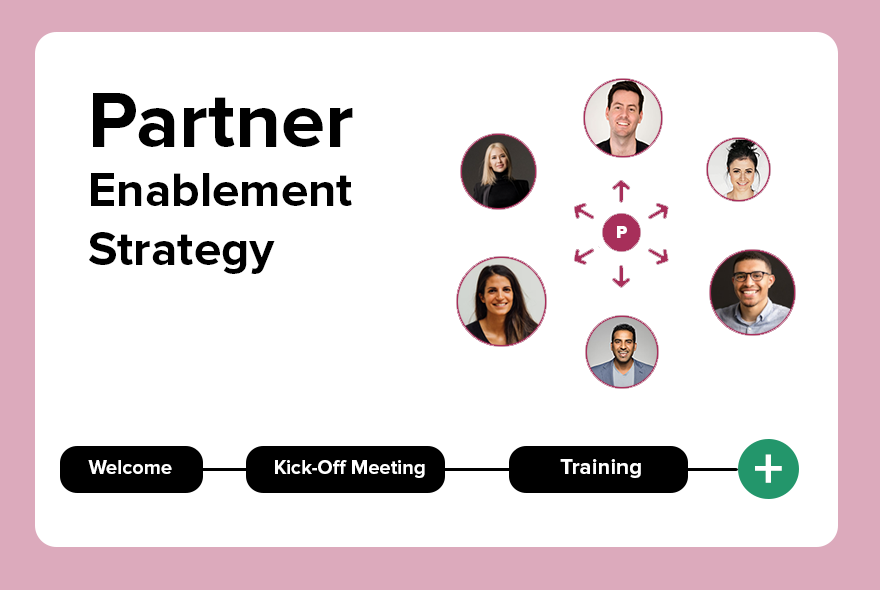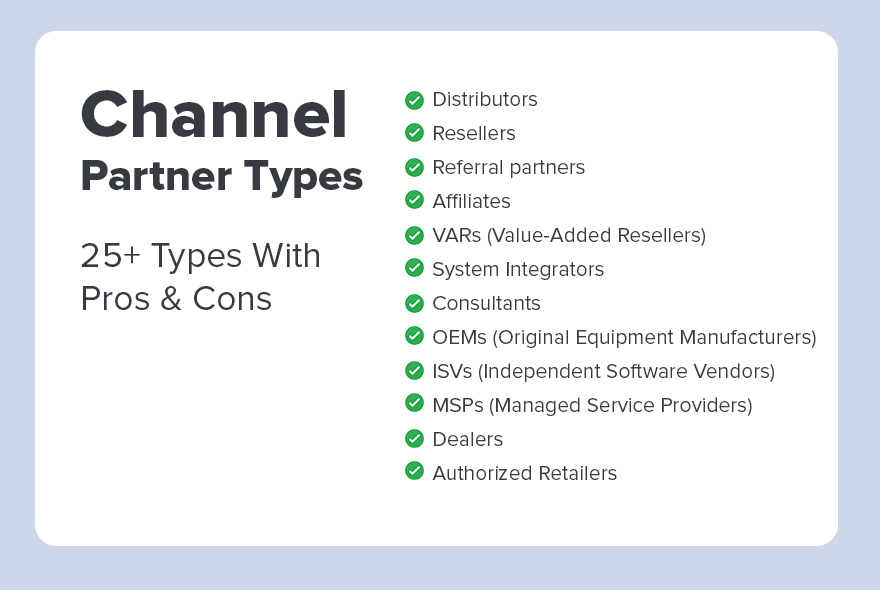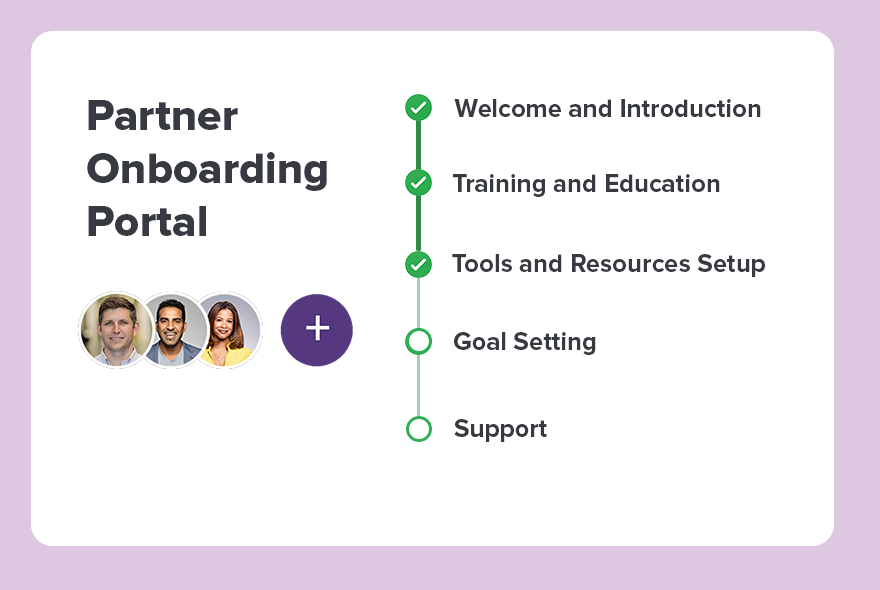In the competitive world of B2B sales, businesses are constantly seeking innovative ways to streamline their operations and increase their bottom line.
Enter digital sales rooms, a strategic solution that merges technology with efficiency to increase profitability.
This modern approach to sales not only simplifies the process but also significantly enhances the effectiveness of sales strategies. Let’s delve into the core advantages they offer.
Table of Content
- Understanding the Concept: What is a Digital Sales Room?
- Key Features of DSR
- Digital Sales Room Example
- Who is Using Digital Sales Rooms?
- What are Key Benefits of Using DSR
- The Digital Sales Room Workflow: How Does it Function?
- Why B2B Businesses Need DSR?
- Creating a High-performing Virtual Sales Room: Key Steps
- The Role of Digital Sales Room in Improving Seller Productivity
- Enhancing Customer Engagement through Digital Sales Rooms
- 8 Best Practices for Efficient Use of Digital Sales Rooms
- The Future of Digital Sales Process Streamlining
- What Are the Trends in B2B Sales for 2024?
- Take Your Next Step
Understanding the Concept: What is a Digital Sales Room?
Digital Sales Room (DSR) is a virtual space crafted to transform the sales journey. It serves as a dynamic, interactive platform where businesses can highlight their products or services, engage directly with prospects, and efficiently close deals.
Imagine it as a customizable digital hub, where all sales-related actions converge, from showcasing to negotiation.
Digital sales rooms are changing the way we sell in 2024, making sales faster and more personal. This is what’s trending in B2B sales now.
Efficiency in closing deals is primary goal. Centralizing essential materials — think presentations, proposals, contracts — DSRs streamline the final steps of the sales process, making it smoother and faster.
With features like video presentations, live chat, and interactive demos, DSRs offer an immersive experience that captivates potential clients, making every interaction more meaningful.
Flexibility is very important aspect of deal rooms. Each DSR can be tailored to fit the unique demands and identity of a business, ensuring a digital sales process that aligns perfectly with its objectives and audience
Key Features of Digital Sales Rooms
- Secure Sharing: Share documents securely with clients. This ensures the confidentiality of sensitive information and also simplifies document management.
- Personalized Content: Customize presentations and proposals directly within the DSR. This personal touch can make a big difference in engaging potential clients.
- Seamless Collaboration: Both sales teams and buyers can communicate and share feedback within the DSR. This streamlines the decision-making process and helps close deals faster.
- Real-Time Activity Tracking: DSRs let you see what your buyers are interested in, in real-time. This insight allows you to tailor your approach and focus on what matters most to them.
- Post-Sell Process: DSRs support the B2B post-sale journey with features like the Mutual Action Plan and tasks tracking. This ensures both parties are aligned on next steps and commitments, facilitating a smoother transition to implementation and fostering long-term relationships.
Digital Sales Room Example
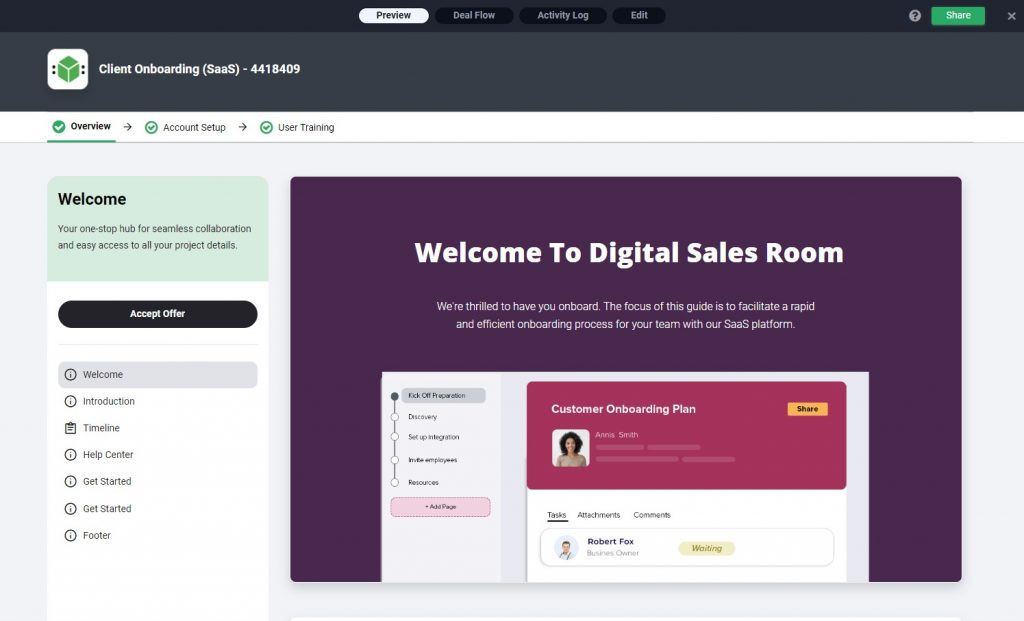
Who is Using Digital Sales Rooms?
Digital Sales Rooms, often referred to as deal rooms, are versatile tools used across various industries and by different professionals to streamline and enhance the sales process. Here’s a look at who is using deal rooms and for what purposes:
Positions:
Sales Representatives: They use deal rooms to present product information, share proposals, and communicate directly with prospects, providing a personalized sales experience.
Account Managers: For managing and growing existing accounts, account managers utilize deal rooms to share updates, new offerings, and contract renewals in a secure environment.
Marketing Professionals: They leverage deal rooms to deliver targeted content and campaigns to potential clients, tracking engagement to refine strategies.
Customer Success Managers: Post-sale, these professionals use deal rooms to ensure clients have all the resources they need for success, facilitating onboarding and ongoing support.
Executives: Senior leaders use deal rooms for high-stakes negotiations, sharing strategic documents and presentations in a secure, professional setting.
Industries and Verticals
Technology: In the fast-paced tech industry, deal rooms are essential for demonstrating software capabilities, sharing case studies, and managing software licensing agreements.
Marketing Agencies: These agencies leverage deal rooms to collaborate on campaigns, share strategies, and report on analytics with clients.
Digital Agencies: Digital agencies use deal rooms for presenting web and app designs, discussing digital marketing strategies, and securely sharing creative content and project updates. Read an example of how to automate agency client onboardin.
Sales Teams Across Industries: Sales teams utilize deal rooms to tailor their pitches, securely share proposals, and negotiate deals, ensuring a personalized and efficient buying experience for each client.
What are Key Benefits of Using Digital Deal Rooms?
DSRs eliminate unnecessary steps, providing all essential sales tools and documents in one accessible location. They foster deeper connections with clients through tailored, engaging content.
Deal Rooms offer ways to refine:
- Sales Efficiency
- Buyer Engagement
- Insight
- Buyer-Seller Collaboration
Real-time analytics shed light on customer behaviors and preferences, allowing for agile adjustments to sales tactics. Furthermore, these platforms facilitate effortless collaboration among team members, regardless of geographical barriers.
Virtual sales rooms are reshaping the landscape of B2B sales, making processes more efficient and helping businesses achieve greater profitability.
The Digital Sales Room Workflow: How Does it Function?
At its core, the digital sales room is a platform enabling sellers to craft, personalize, and distribute their virtual sales environments.
After launching and sharing your digital space, the real magic begins.
Foundational Elements of Digital Sales Room Success:
- Flexibility
- Customization
- Interaction
- Tracking
- Management
- Automation
Flexibility shines as you navigate through the creation of various rooms, each serving a unique purpose or targeting a specific audience.
Customization is at your fingertips, allowing you to inject your brand’s personality and tailor the content to meet your customers’ needs and interests.
Interaction becomes more engaging and productive. With tools at your disposal for live discussions, feedback collection, and presentations, every conversation can be a step closer to sealing the deal.
Tracking capabilities let you see which parts of your sales room are hitting the mark. Monitor visits, document views, and overall engagement to fine-tune your approach in real-time.
Management of the sales process becomes smoother as you centralize communications, resources, and negotiations in one shared digital space.
Automation in digital sales rooms software streamlines repetitive tasks, from scheduling meetings to sending follow-up emails, freeing up time for more strategic activities. It also ensures personalized customer experiences at scale, by customizing content and communications based on prospect behavior and preferences.
Why B2B Businesses Need Digital Sales Rooms?
Digital sales rooms are not simply a trendy concept, but a necessary evolution in the B2B landscape. The complexity of B2B sales cycle — multiple stakeholders, non-linear buying processes, and endless email threads — demands a more organized, efficient, and streamlined sales process.
DSRs help businesses consolidate conversations, stakeholders, processes, and resources, ultimately improving conversion rates and customer experience.
Creating a High-performing Virtual Sales Room: Key Steps
The journey to an effective virtual sales room begins with selecting a platform that meshes well with your business objectives.
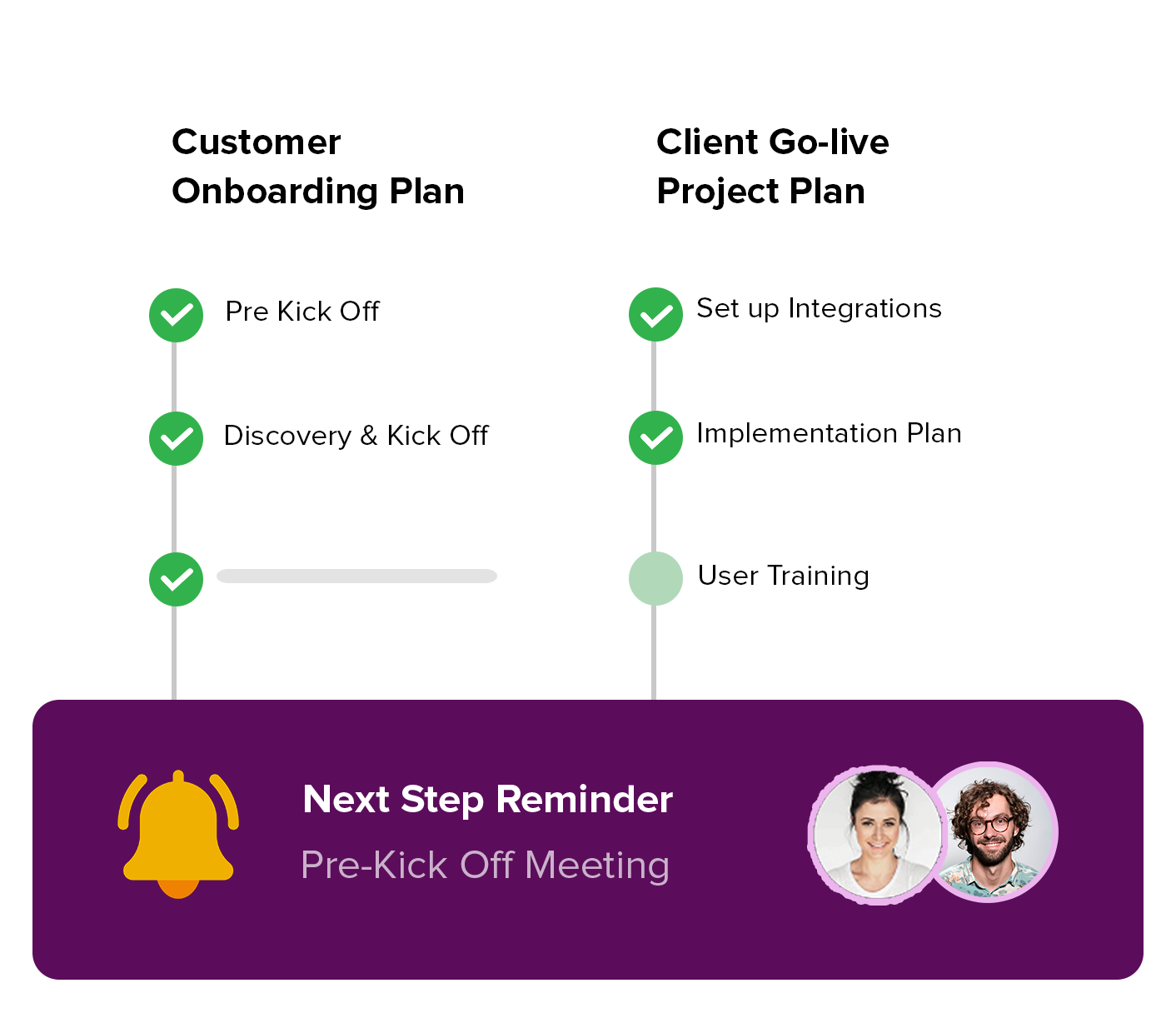
After settling on the perfect fit, you’ll move on to populating it with essential documents and materials. This process isn’t just about uploading files; it’s about curating content that resonates.
Here’s a streamlined guide to seamlessly integrate this innovative tool into your business framework, structured to fit naturally within an article narrative:
Step 1: Choosing the Right Platform
Our quest begins with selecting a platform that resonates with your business goals. This foundational step is crucial, as the chosen platform sets the stage for what comes next. It’s about finding a digital sales room software that not only supports but amplifies your sales objectives.
Step 2: Curating and Uploading Content
Once your platform is set, the next phase involves the thoughtful curation and uploading of content. This step goes beyond mere document storage; it’s about creating a compelling narrative for your products or services. Each piece of content should serve a purpose, aiming to engage and inform your prospects.
Step 3: Customizing the Experience
After populating your digital sales room with content, customization takes center stage. This involves adjusting the interface to reflect your brand’s identity. Customization is key to creating a user-friendly experience that feels both personal and professional, encouraging users to explore and engage.
Step 4: Engaging with Prospects
The final step is where your room truly comes to life: engagement. Sharing your platform with potential clients and starting real-time interactions marks the culmination of your efforts. This stage is about building relationships, offering tailored responses, and adapting to feedback in a dynamic, interactive setting.
Integrating these steps into your sales strategy not only streamlines the process but also opens up new avenues for engagement and conversion. By thoughtfully selecting a platform, curating content, customizing the user experience, and actively engaging with prospects, businesses can create a digital sales room that stands out in today’s competitive marketplace.
The Role of Digital Sales Rooms in Improving Seller Productivity
Consolidating all sales-related processes in a single shared space, digital sales rooms software eliminates the need for back-and-forth emails and scattered resources, thereby saving significant time and effort.
This increased efficiency accelerates the digital sales process and improves seller productivity, enabling them to focus more on strategic tasks and less on administrative ones.

Enhancing Customer Engagement through Digital Sales Rooms
Digital sales rooms allow for real-time interaction with prospects, providing a personalized and immersive experience. This fosters deeper engagement and builds stronger relationships, which are critical for driving conversions and customer loyalty.
Using DocsCube Deal Rooms as Digital Sales Rooms centralizes your resources, providing a unified, personalized platform for customer engagement.
The real power of DocsCube lies in its ability to streamline the sharing of crucial sales and project information. From detailed meeting summaries that capture every discussion point to dynamic multimedia presentations that bring your offerings to life, DocsCube ensures that every piece of content is easily accessible and engaging for your prospects.
Here’s how DocsCube increases customer engagement:
- Streamlined Sharing: Easily share everything from detailed meeting summaries to engaging multimedia presentations. This ensures all content is accessible and captivating for your prospects.
- Enhanced Customer Experience: The capability to update and receive feedback in real-time keeps conversations with customers active and productive. Accessibility to all relevant materials in one spot simplifies the sales journey for both parties.
- Automated Efficiency: DocsCube automates repetitive tasks, such as follow-ups and content distribution, freeing up more time to focus on strategic sales activities. This automation ensures that every aspect of the sales room operates smoothly and efficiently, enhancing overall productivity.
- Stronger Relationships: By facilitating a seamless, interactive experience, DocsCube fosters deeper understanding and trust. This is crucial for building meaningful connections that lead to successful outcomes.
DocsCube isn’t just about sharing information; it’s about leveraging automation to create a dynamic space where every interaction is an opportunity to deepen customer relationships and drive engagement.
8 Best Practices for Efficient Use of Digital Sales Rooms
To maximize the benefits of digital sales rooms, it’s crucial to follow best practices. These include ensuring a smooth and intuitive user interface, maintaining a logical and organized document structure, and providing comprehensive and up-to-date product or service information. Regularly reviewing and updating your DSR based on customer feedback and interaction data can also lead to continuous improvement and better performance.
To harness the full power of digital sales rooms effectively, here are numbered best practices crucial for optimizing engagement and enhancing performance:
- Simplify Navigation: Design your digital sales room with a user-friendly interface, ensuring information is easy to access and understand.
- Organize Content: Maintain a logical structure for your documents and materials, allowing visitors to navigate and find what they need effortlessly.
- Update Regularly: Keep all product and service information up to date. Consistent updates showcase your commitment to accuracy and quality.
- Gather Feedback: Implement feedback tools within your digital sales room to capture visitor impressions and suggestions on-the-fly.
- Analyze Interactions: Employ analytics to gain insights into visitor behavior, including the most frequented sections and the effectiveness of your navigation layout.
- Personalize Experiences: Use visitor data to customize the digital sales room experience, making every interaction more relevant and engaging.
- Automate for Efficiency: Leverage automation for updates, alerts, and follow-ups to streamline operations and maintain timely communication.
- Train Your Team: Regularly train your sales team on the best practices and functionalities of your digital sales room to maximize its potential.
Following these steps will ensure your B2B sales room is not just a platform for showcasing your products or services but a dynamic space that fosters engagement, builds relationships, and drives sales.
The Future of Digital Sales Process Streamlining
Centralizing the B2B sales process revolutionizes buyer expectations by blending advanced technology with a personal touch, it makes every deal smoother and smarter.
They simplify the sales journey, enhance customer engagement by centralizing resources and automating tasks.
Integration of AI and Machine Learning in B2B Sales Cycle
One of the most exciting changes in B2B sales is the integration of AI and machine learning technologies. These tools can analyze customer data to provide personalized recommendations, automate repetitive tasks, and even predict future buying behaviors.
A Gartner report suggests that by 2025, AI will be a pivotal player in over 90% of B2B sales processes, significantly reducing the sales cycle and enhancing customer experiences.
Virtual Reality (VR) and Augmented Reality (AR) in Sales
Another game-changer is the adoption of VR and AR technologies in B2B sales.
Imagine being able to demonstrate a product in a virtual environment or overlaying a digital twin of a machine in its future environment.
Forbes reports that companies incorporating AR/VR into their sales strategies see a 30% increase in customer engagement rates.
What Are the Trends in B2B Sales for 2024?
In 2024, an increasing number of buyers are seeking a seller-free experience, favoring platforms that allow them to navigate the purchasing journey autonomously.
Self-Service Platforms: Buyers prefer platforms where they can independently explore products, services, and solutions without needing to interact with a salesperson.
Instant Access to Information: Expectations include immediate access to detailed product information, pricing, and availability, allowing for informed decision-making.
Customization and Personalization: Buyers seek systems that tailor the buying experience to their specific needs and preferences based on their browsing and purchase history.
Seamless Integration: A desire for sales platforms that integrate smoothly with their own procurement systems for easier order processing and management.
Take Your Next Step
Transform your B2B sales with DocsCube Deal Room pre-built templates. These ready-to-use solutions are your gateway to harnessing the full power of DSRs quickly and efficiently. From improving engagement to streamlining processes, DocsCube templates provide an immediate boost to your sales efforts.
Embrace the efficiency and profitability of the future — explore DocsCube Deal Room examples today.
Try Deal Rooms today and take a significant step towards optimizing your B2B sales process.
Eliminate delays by sharing a mutual action plan with all key stakeholders. Standardize processes, automate notifications, and create a transparent onboarding plan.
Try Now ― It’s Free
